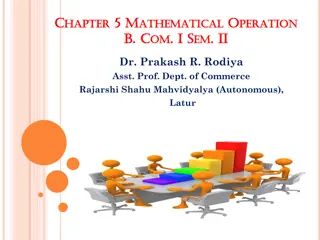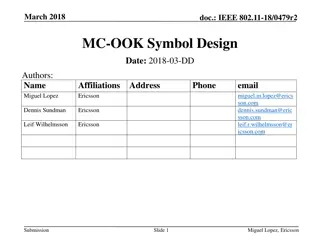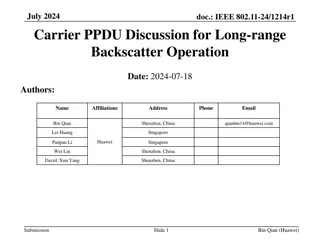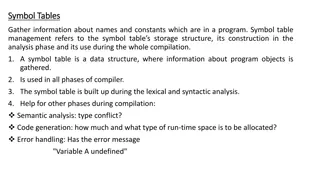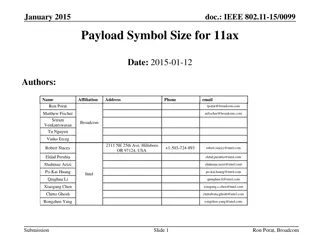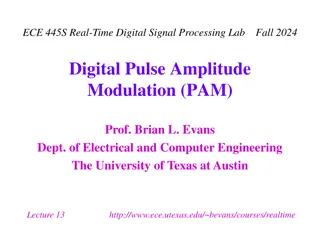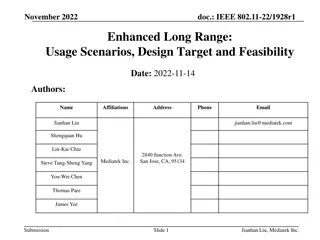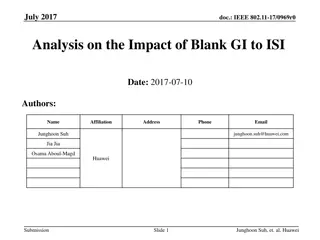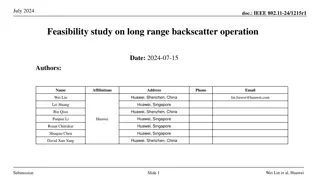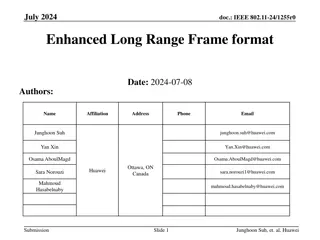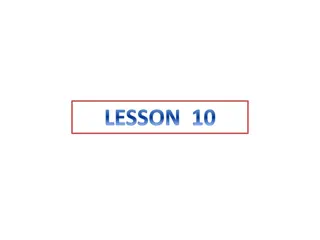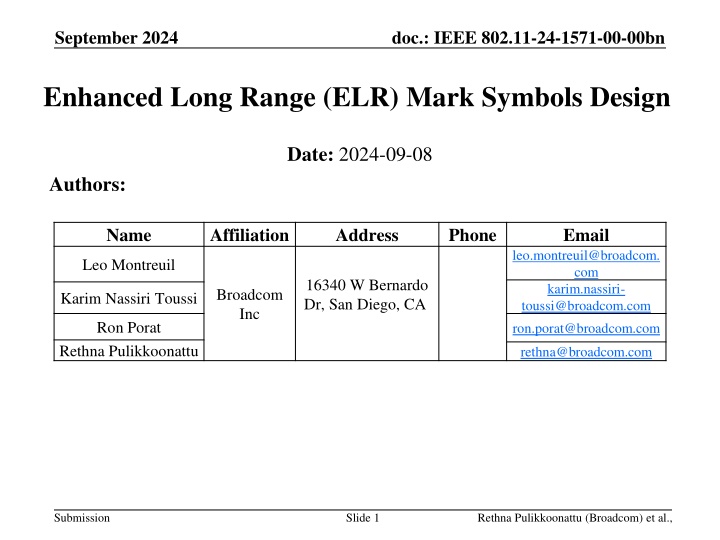
Enhanced Long Range (ELR) Symbols Design for IEEE 802.11-24-1571-00-00bn
Explore the proposal for Enhanced Long Range (ELR) technology within the IEEE 802.11bn standard, focusing on the design of ELR-Mark symbols to improve detection performance under low signal conditions. Learn about the rationale behind ELR-Mark symbols, their positioning in the preamble, and their benefits for coherent combining across antennas.
Download Presentation

Please find below an Image/Link to download the presentation.
The content on the website is provided AS IS for your information and personal use only. It may not be sold, licensed, or shared on other websites without obtaining consent from the author. If you encounter any issues during the download, it is possible that the publisher has removed the file from their server.
You are allowed to download the files provided on this website for personal or commercial use, subject to the condition that they are used lawfully. All files are the property of their respective owners.
The content on the website is provided AS IS for your information and personal use only. It may not be sold, licensed, or shared on other websites without obtaining consent from the author.
E N D
Presentation Transcript
September 2024 doc.: IEEE 802.11-24-1571-00-00bn Enhanced Long Range (ELR) Mark Symbols Design Date: 2024-09-08 Authors: Name Affiliation Address Phone Email leo.montreuil@broadcom. com karim.nassiri- toussi@broadcom.com ron.porat@broadcom.com Leo Montreuil 16340 W Bernardo Dr, San Diego, CA Broadcom Inc Karim Nassiri Toussi Ron Porat Rethna Pulikkoonattu rethna@broadcom.com Submission Slide 1 Rethna Pulikkoonattu (Broadcom) et al.,
September 2024 doc.: IEEE 802.11-24-1571-00-00bn Introduction The topic of Enhanced Long Range (ELR) was previously presented to the UHR study group to improve uplink range and address the link budget imbalance between downlink and uplink [1,2]. The goal of introducing the ELR technology in 11bn is to enable long-range reception of single-stream, low-data-rate (1-2 Mbps) PPDUs, even under very low RSSI conditions. We believe the best approach is for the introduced ELR format to closely follow the standard 11bn/UHR preamble and data formats, minimizing the need for entirely new detection, modulation, and coding schemes. This enables most existing transmitter and receiver designs to be reused with only minor modifications. This presentation mainly focus on the design of the ELR preamble, where we propose the introduction of ELR-Mark symbols to enhance ELR detection. Submission Slide 2 Rethna Pulikkoonattu (Broadcom) et al.,
September 2024 doc.: IEEE 802.11-24-1571-00-00bn Enhanced Long Range (ELR) Preamble It is suggested to restrict the ELR PPDU within 20 MHz bandwidth [1] The LSIG, R-LSIG, USIG1, and USIG2 fields follow the standard UHR format, except for the USIG contents, which are uniquely configured to signal ELR Following the USIG, two ELR-Mark symbols with the same format as L-LTF are transmitted, with the specific details outlined in the subsequent slides ELR-STF/LTF/SIG design is TBD Submission Slide 3 Rethna Pulikkoonattu (Broadcom) et al.,
September 2024 doc.: IEEE 802.11-24-1571-00-00bn Why ELR-Mark Symbols? The 802.11ax introduced power boost for the L-STF and L-LTF fields, but the expected gains in preamble detection were not fully realized, as the method depended on auto-correlation of unknown incoming signals, limiting the detection performance for both standard 802.11ax and Extended Range (ER). For 802.11bn, in the ELR preamble, we propose to introduce two ELR-Mark symbols with a predefined tone pattern. By leveraging channel estimation from the boosted L-LTF, ELR-Mark symbols can be detected through cross-correlation with the known pattern in the frequency domain, enabling coherent combining across receiving antennas. The ELR Mark symbol sequences can be designed to optimize detection performances (minimize missed and false detection probabilities). ELR-Mark symbols are positioned after LSIG, R-LSIG, and UHR USIG to ensure that third-party non-ELR STAs can correctly decode the USIG and take appropriate actions. In scenarios with very low SNR (typical operating conditions for ELR), where LSIG, R-LSIG, and USIG cannot be reliably decoded, an ELR receiver can still detect the ELR-Mark symbols and proceed. Submission Slide 4 Rethna Pulikkoonattu (Broadcom) et al.,
September 2024 doc.: IEEE 802.11-24-1571-00-00bn ELR Mark Symbols (1) ELR Mark consists of 2-OFDM symbols (ELR-Mark1 and ELR-Mark2), which serve two purposes Classify ELR-PPDU Carry BSS color information (64 BSS colors necessitates 64 orthogonal sequences) Each OFDM symbol will comprise a 52-tone block consisting of four pilot tones and 48 data tones, with the 48 data tones carrying the ELR mark sequence. Each symbol will have duration of 4 S (i.e., 3.2 S + GI=0.8 S). The ELR mark is defined in the form of duo-binary sequence block of 48 elements, which are mapped to Q-BPSK symbols (i.e., j). The pilots in the ELR symbols are BPSK modulated (i.e., 1). ELR Mark Matrix: The 64x96 orthogonal matrix H is built from a 32x48 orthogonal matrix H through: Note: Multiplying with exchange matrix ? may be implemented by reversal of columns (e.g., MATLAB syntax). H64x96= [ +H32x48, +H32x48(:,48:-1:1) +H32x48 , -H32x48(:,48:-1:1) ] where, each row of H is deemed such that the first 48 elements correspond to Mark1 and the second 48 entries fills the data tones of Mark2. ? is 48x48 exchange matrix [3]. Slide 5 Submission Rethna Pulikkoonattu (Broadcom) et al.,
doc.: IEEE 802.11-24-1571-00-00bn September 2024 ELR Mark Symbols (2) The rows 1 to 64 of matrix H correspond to BSS colors 1 to 64. Columns 1 to 48 of H are transmitted on the data portion (48 tones) of the first symbol (mark1), while columns 49 to 96 are transmitted on the data portion (48 tones) of the second symbol (mark2). H is an orthogonal matrix. Detection performance, especially the probability of missed detection and probability of false alarms, must be acceptable at low SNR levels, down to -9 dB. Since the leading cause of false alarms is OBSS interference (misclassifying to an incorrect but legitimate ELR Mark sequence), minimizing the worst-case false alarm probability is crucial for robust ELR performance. A lower PAPR is preferred for the ELR sequence to enhance transmitter efficiency. Submission Slide 6 Rethna Pulikkoonattu (Broadcom) et al.,
doc.: IEEE 802.11-24-1571-00-00bn September 2024 ELR marker tone plan (Q-BPSK) ELR mark sequence is composite of two OFDM symbols (48 data tones and 4 pilots) The data tones are Q-BPSK mapped, and pilots are modulated using BPSK Submission Rethna Pulikkoonattu (Broadcom) et al., Slide 7
doc.: IEEE 802.11-24-1571-00-00bn September 2024 Q-BPSK-32x48 ELR mark base Matrix, H [ -1,-1,-1,-1,1,-1,-1,-1,-1,1,1,-1,1,-1,1,-1,-1,-1,1,1,-1,1,1,-1,-1,1,-1,-1,1,1,1,-1,1,-1,1,-1,-1,1,1,1,1,-1,1,1,1,1,1,-1 1,-1,-1,-1,-1,1,1,-1,1,-1,1,-1,-1,-1,1,1,-1,1,1,-1,-1,1,-1,-1,1,1,1,-1,1,-1,1,-1,-1,1,1,1,1,-1,1,1,1,1,1,-1,-1,-1,-1,-1 -1,-1,-1,-1,1,1,-1,1,-1,1,-1,-1,-1,1,1,-1,1,1,-1,-1,1,-1,-1,1,1,1,-1,1,-1,1,-1,-1,1,1,1,1,-1,1,1,1,1,1,-1,-1,-1,-1,1,-1 -1,-1,-1,1,1,-1,1,-1,1,-1,-1,-1,1,1,-1,1,1,-1,-1,1,-1,-1,1,1,1,-1,1,-1,1,-1,-1,1,1,1,1,-1,1,1,1,1,1,-1,-1,-1,-1,1,-1,-1 -1,-1,1,1,-1,1,-1,1,-1,-1,-1,1,1,-1,1,1,-1,-1,1,-1,-1,1,1,1,-1,1,-1,1,-1,-1,1,1,1,1,-1,1,1,1,1,1,-1,-1,-1,-1,1,-1,-1,-1 -1,1,1,-1,1,-1,1,-1,-1,-1,1,1,-1,1,1,-1,-1,1,-1,-1,1,1,1,-1,1,-1,1,-1,-1,1,1,1,1,-1,1,1,1,1,1,-1,-1,-1,-1,1,-1,-1,-1,-1 1,1,-1,1,-1,1,-1,-1,-1,1,1,-1,1,1,-1,-1,1,-1,-1,1,1,1,-1,1,-1,1,-1,-1,1,1,1,1,-1,1,1,1,1,1,-1,-1,-1,-1,1,-1,-1,-1,-1,-1 1,-1,1,-1,1,-1,-1,-1,1,1,-1,1,1,-1,-1,1,-1,-1,1,1,1,-1,1,-1,1,-1,-1,1,1,1,1,-1,1,1,1,1,1,-1,-1,-1,-1,1,-1,-1,-1,-1,1,-1 1,-1,1,-1,-1,-1,1,1,-1,1,1,-1,-1,1,-1,-1,1,1,1,-1,1,-1,1,-1,-1,1,1,1,1,-1,1,1,1,1,1,-1,-1,-1,-1,1,-1,-1,-1,-1,1,1,-1,-1 -1,1,-1,-1,-1,1,1,-1,1,1,-1,-1,1,-1,-1,1,1,1,-1,1,-1,1,-1,-1,1,1,1,1,-1,1,1,1,1,1,-1,-1,-1,-1,1,-1,-1,-1,-1,1,1,-1,1,-1 1,-1,-1,-1,1,1,-1,1,1,-1,-1,1,-1,-1,1,1,1,-1,1,-1,1,-1,-1,1,1,1,1,-1,1,1,1,1,1,-1,-1,-1,-1,1,-1,-1,-1,-1,1,1,-1,1,-1,-1 -1,-1,-1,1,1,-1,1,1,-1,-1,1,-1,-1,1,1,1,-1,1,-1,1,-1,-1,1,1,1,1,-1,1,1,1,1,1,-1,-1,-1,-1,1,-1,-1,-1,-1,1,1,-1,1,-1,1,-1 -1,-1,1,1,-1,1,1,-1,-1,1,-1,-1,1,1,1,-1,1,-1,1,-1,-1,1,1,1,1,-1,1,1,1,1,1,-1,-1,-1,-1,1,-1,-1,-1,-1,1,1,-1,1,-1,1,-1,-1 -1,1,1,-1,1,1,-1,-1,1,-1,-1,1,1,1,-1,1,-1,1,-1,-1,1,1,1,1,-1,1,1,1,1,1,-1,-1,-1,-1,1,-1,-1,-1,-1,1,1,-1,1,-1,1,-1,-1,-1 1,1,-1,1,1,-1,-1,1,-1,-1,1,1,1,-1,1,-1,1,-1,-1,1,1,1,1,-1,1,1,1,1,1,-1,-1,-1,-1,1,-1,-1,-1,-1,1,1,-1,1,-1,1,-1,-1,-1,-1 -1,1,1,-1,-1,1,-1,-1,1,1,1,-1,1,-1,1,-1,-1,1,1,1,1,-1,1,1,1,1,1,-1,-1,-1,-1,1,-1,-1,-1,-1,1,1,-1,1,-1,1,-1,-1,-1,1,1,-1 -1,-1,1,-1,-1,1,1,1,-1,1,-1,1,-1,-1,1,1,1,1,-1,1,1,1,1,1,-1,-1,-1,-1,1,-1,-1,-1,-1,1,1,-1,1,-1,1,-1,-1,-1,1,1,-1,1,1,-1 -1,1,-1,-1,1,1,1,-1,1,-1,1,-1,-1,1,1,1,1,-1,1,1,1,1,1,-1,-1,-1,-1,1,-1,-1,-1,-1,1,1,-1,1,-1,1,-1,-1,-1,1,1,-1,1,1,-1,-1 1,-1,-1,1,1,1,-1,1,-1,1,-1,-1,1,1,1,1,-1,1,1,1,1,1,-1,-1,-1,-1,1,-1,-1,-1,-1,1,1,-1,1,-1,1,-1,-1,-1,1,1,-1,1,1,-1,-1,-1 -1,-1,1,1,1,-1,1,-1,1,-1,-1,1,1,1,1,-1,1,1,1,1,1,-1,-1,-1,-1,1,-1,-1,-1,-1,1,1,-1,1,-1,1,-1,-1,-1,1,1,-1,1,1,-1,-1,1,-1 -1,1,1,1,-1,1,-1,1,-1,-1,1,1,1,1,-1,1,1,1,1,1,-1,-1,-1,-1,1,-1,-1,-1,-1,1,1,-1,1,-1,1,-1,-1,-1,1,1,-1,1,1,-1,-1,1,-1,-1 1,1,1,-1,1,-1,1,-1,-1,1,1,1,1,-1,1,1,1,1,1,-1,-1,-1,-1,1,-1,-1,-1,-1,1,1,-1,1,-1,1,-1,-1,-1,1,1,-1,1,1,-1,-1,1,-1,-1,-1 1,1,-1,1,-1,1,-1,-1,1,1,1,1,-1,1,1,1,1,1,-1,-1,-1,-1,1,-1,-1,-1,-1,1,1,-1,1,-1,1,-1,-1,-1,1,1,-1,1,1,-1,-1,1,-1,-1,1,-1 1,-1,1,-1,1,-1,-1,1,1,1,1,-1,1,1,1,1,1,-1,-1,-1,-1,1,-1,-1,-1,-1,1,1,-1,1,-1,1,-1,-1,-1,1,1,-1,1,1,-1,-1,1,-1,-1,1,1,-1 -1,1,-1,1,-1,-1,1,1,1,1,-1,1,1,1,1,1,-1,-1,-1,-1,1,-1,-1,-1,-1,1,1,-1,1,-1,1,-1,-1,-1,1,1,-1,1,1,-1,-1,1,-1,-1,1,1,1,-1 1,-1,1,-1,-1,1,1,1,1,-1,1,1,1,1,1,-1,-1,-1,-1,1,-1,-1,-1,-1,1,1,-1,1,-1,1,-1,-1,-1,1,1,-1,1,1,-1,-1,1,-1,-1,1,1,1,-1,-1 -1,-1,1,1,1,1,-1,1,1,1,1,1,-1,-1,-1,-1,1,-1,-1,-1,-1,1,1,-1,1,-1,1,-1,-1,-1,1,1,-1,1,1,-1,-1,1,-1,-1,1,1,1,-1,1,-1,1,-1 -1,1,1,1,1,-1,1,1,1,1,1,-1,-1,-1,-1,1,-1,-1,-1,-1,1,1,-1,1,-1,1,-1,-1,-1,1,1,-1,1,1,-1,-1,1,-1,-1,1,1,1,-1,1,-1,1,-1,-1 1,1,1,1,-1,1,1,1,1,1,-1,-1,-1,-1,1,-1,-1,-1,-1,1,1,-1,1,-1,1,-1,-1,-1,1,1,-1,1,1,-1,-1,1,-1,-1,1,1,1,-1,1,-1,1,-1,-1,-1 1,1,1,-1,1,1,1,1,1,-1,-1,-1,-1,1,-1,-1,-1,-1,1,1,-1,1,-1,1,-1,-1,-1,1,1,-1,1,1,-1,-1,1,-1,-1,1,1,1,-1,1,-1,1,-1,-1,1,-1 1,-1,1,1,1,1,1,-1,-1,-1,-1,1,-1,-1,-1,-1,1,1,-1,1,-1,1,-1,-1,-1,1,1,-1,1,1,-1,-1,1,-1,-1,1,1,1,-1,1,-1,1,-1,-1,1,1,1,-1 1,1,1,1,1,-1,-1,-1,-1,1,-1,-1,-1,-1,1,1,-1,1,-1,1,-1,-1,-1,1,1,-1,1,1,-1,-1,1,-1,-1,1,1,1,-1,1,-1,1,-1,-1,1,1,1,1,-1,-1] Submission Slide 8 Rethna Pulikkoonattu (Broadcom) et al.,
doc.: IEEE 802.11-24-1571-00-00bn September 2024 The 64x96 Q-BPSK-ELR-mark Matrix, H Submission Slide 9 Rethna Pulikkoonattu (Broadcom) et al.,
doc.: IEEE 802.11-24-1571-00-00bn September 2024 Detection Performance : 1x2 D-NLOS No RF impairments Submission Slide 10 Rethna Pulikkoonattu (Broadcom) et al.,
doc.: IEEE 802.11-24-1571-00-00bn September 2024 Detection Performance : 1x2 D-NLOS With residual CFO Submission Slide 11 Rethna Pulikkoonattu (Broadcom) et al.,
doc.: IEEE 802.11-24-1571-00-00bn September 2024 Detection Performance : 2x4 D-NLOS With residual CFO Submission Slide 12 Rethna Pulikkoonattu (Broadcom) et al.,
doc.: IEEE 802.11-24-1571-00-00bn September 2024 H : PAPR of the ELR marker sequence (Q-BPSK) Submission Rethna Pulikkoonattu (Broadcom) et al., Slide 13
doc.: IEEE 802.11-24-1571-00-00bn Conclusions September 2024 We proposed an ELR preamble design which includes two ELR-Mark symbols to facilitate improved ELR detection. We proposed orthogonal 64x96 Q-BPSK matrix sequences for the ELR marker, which offer strong detection properties while maintaining a lower desired PAPR. The 64x96 ELR mark matrix is derived from a more compact 32x48 matrix, allowing for efficient storage management. Submission Slide 14 Rethna Pulikkoonattu (Broadcom) et al.,
doc.: IEEE 802.11-24-1571-00-00bn September 2024 References 1. Design Targets and Considerations for Enhanced Long Range , IEEE 802.11- 24/0873r2 2. An Enhanced Long Range PPDU , IEEE 802.11-24/0921r0 3. Wikipedia, The Free Encyclopedia, s.v. " Exchange matrix," (accessed September 7, 2024), https://en.wikipedia.org/wiki/Exchange_matrix Submission Rethna Pulikkoonattu (Broadcom) et al., Slide 15
September 2024 doc.: IEEE 802.11-24-1571-00-00bn Straw Poll -1 Do you support using ELR Mark symbols that consist of two 1x OFDM symbols? Each symbol will have duration of 4 S (3.2 S + GI=0.8 S). Submission Rethna Pulikkoonattu (Broadcom) et al., Slide 16
September 2024 doc.: IEEE 802.11-24-1571-00-00bn Straw Poll -2 Do you support using ELR Mark symbols with the following tone mapping? The 48 data tones are Q-BPSK mapped The pilots follow BPSK mapping (as in L-LTF) Submission Rethna Pulikkoonattu (Broadcom) et al., Slide 17
doc.: IEEE 802.11-24-1571-00-00bn Straw Poll -3 September 2024 Do you support adopting the ELR Mark sequence design as described by the matrix H. H=[ -1,-1,-1,-1,1,-1,-1,-1,-1,1,1,-1,1,-1,1,-1,-1,-1,1,1,-1,1,1,-1,-1,1,-1,-1,1,1,1,-1,1,-1,1,-1,-1,1,1,1,1,-1,1,1,1,1,1,-1 1,-1,-1,-1,-1,1,1,-1,1,-1,1,-1,-1,-1,1,1,-1,1,1,-1,-1,1,-1,-1,1,1,1,-1,1,-1,1,-1,-1,1,1,1,1,-1,1,1,1,1,1,-1,-1,-1,-1,-1 -1,-1,-1,-1,1,1,-1,1,-1,1,-1,-1,-1,1,1,-1,1,1,-1,-1,1,-1,-1,1,1,1,-1,1,-1,1,-1,-1,1,1,1,1,-1,1,1,1,1,1,-1,-1,-1,-1,1,-1 -1,-1,-1,1,1,-1,1,-1,1,-1,-1,-1,1,1,-1,1,1,-1,-1,1,-1,-1,1,1,1,-1,1,-1,1,-1,-1,1,1,1,1,-1,1,1,1,1,1,-1,-1,-1,-1,1,-1,-1 -1,-1,1,1,-1,1,-1,1,-1,-1,-1,1,1,-1,1,1,-1,-1,1,-1,-1,1,1,1,-1,1,-1,1,-1,-1,1,1,1,1,-1,1,1,1,1,1,-1,-1,-1,-1,1,-1,-1,-1 -1,1,1,-1,1,-1,1,-1,-1,-1,1,1,-1,1,1,-1,-1,1,-1,-1,1,1,1,-1,1,-1,1,-1,-1,1,1,1,1,-1,1,1,1,1,1,-1,-1,-1,-1,1,-1,-1,-1,-1 1,1,-1,1,-1,1,-1,-1,-1,1,1,-1,1,1,-1,-1,1,-1,-1,1,1,1,-1,1,-1,1,-1,-1,1,1,1,1,-1,1,1,1,1,1,-1,-1,-1,-1,1,-1,-1,-1,-1,-1 1,-1,1,-1,1,-1,-1,-1,1,1,-1,1,1,-1,-1,1,-1,-1,1,1,1,-1,1,-1,1,-1,-1,1,1,1,1,-1,1,1,1,1,1,-1,-1,-1,-1,1,-1,-1,-1,-1,1,-1 1,-1,1,-1,-1,-1,1,1,-1,1,1,-1,-1,1,-1,-1,1,1,1,-1,1,-1,1,-1,-1,1,1,1,1,-1,1,1,1,1,1,-1,-1,-1,-1,1,-1,-1,-1,-1,1,1,-1,-1 -1,1,-1,-1,-1,1,1,-1,1,1,-1,-1,1,-1,-1,1,1,1,-1,1,-1,1,-1,-1,1,1,1,1,-1,1,1,1,1,1,-1,-1,-1,-1,1,-1,-1,-1,-1,1,1,-1,1,-1 1,-1,-1,-1,1,1,-1,1,1,-1,-1,1,-1,-1,1,1,1,-1,1,-1,1,-1,-1,1,1,1,1,-1,1,1,1,1,1,-1,-1,-1,-1,1,-1,-1,-1,-1,1,1,-1,1,-1,-1 -1,-1,-1,1,1,-1,1,1,-1,-1,1,-1,-1,1,1,1,-1,1,-1,1,-1,-1,1,1,1,1,-1,1,1,1,1,1,-1,-1,-1,-1,1,-1,-1,-1,-1,1,1,-1,1,-1,1,-1 -1,-1,1,1,-1,1,1,-1,-1,1,-1,-1,1,1,1,-1,1,-1,1,-1,-1,1,1,1,1,-1,1,1,1,1,1,-1,-1,-1,-1,1,-1,-1,-1,-1,1,1,-1,1,-1,1,-1,-1 -1,1,1,-1,1,1,-1,-1,1,-1,-1,1,1,1,-1,1,-1,1,-1,-1,1,1,1,1,-1,1,1,1,1,1,-1,-1,-1,-1,1,-1,-1,-1,-1,1,1,-1,1,-1,1,-1,-1,-1 1,1,-1,1,1,-1,-1,1,-1,-1,1,1,1,-1,1,-1,1,-1,-1,1,1,1,1,-1,1,1,1,1,1,-1,-1,-1,-1,1,-1,-1,-1,-1,1,1,-1,1,-1,1,-1,-1,-1,-1 -1,1,1,-1,-1,1,-1,-1,1,1,1,-1,1,-1,1,-1,-1,1,1,1,1,-1,1,1,1,1,1,-1,-1,-1,-1,1,-1,-1,-1,-1,1,1,-1,1,-1,1,-1,-1,-1,1,1,-1 -1,-1,1,-1,-1,1,1,1,-1,1,-1,1,-1,-1,1,1,1,1,-1,1,1,1,1,1,-1,-1,-1,-1,1,-1,-1,-1,-1,1,1,-1,1,-1,1,-1,-1,-1,1,1,-1,1,1,-1 -1,1,-1,-1,1,1,1,-1,1,-1,1,-1,-1,1,1,1,1,-1,1,1,1,1,1,-1,-1,-1,-1,1,-1,-1,-1,-1,1,1,-1,1,-1,1,-1,-1,-1,1,1,-1,1,1,-1,-1 1,-1,-1,1,1,1,-1,1,-1,1,-1,-1,1,1,1,1,-1,1,1,1,1,1,-1,-1,-1,-1,1,-1,-1,-1,-1,1,1,-1,1,-1,1,-1,-1,-1,1,1,-1,1,1,-1,-1,-1 -1,-1,1,1,1,-1,1,-1,1,-1,-1,1,1,1,1,-1,1,1,1,1,1,-1,-1,-1,-1,1,-1,-1,-1,-1,1,1,-1,1,-1,1,-1,-1,-1,1,1,-1,1,1,-1,-1,1,-1 -1,1,1,1,-1,1,-1,1,-1,-1,1,1,1,1,-1,1,1,1,1,1,-1,-1,-1,-1,1,-1,-1,-1,-1,1,1,-1,1,-1,1,-1,-1,-1,1,1,-1,1,1,-1,-1,1,-1,-1 1,1,1,-1,1,-1,1,-1,-1,1,1,1,1,-1,1,1,1,1,1,-1,-1,-1,-1,1,-1,-1,-1,-1,1,1,-1,1,-1,1,-1,-1,-1,1,1,-1,1,1,-1,-1,1,-1,-1,-1 1,1,-1,1,-1,1,-1,-1,1,1,1,1,-1,1,1,1,1,1,-1,-1,-1,-1,1,-1,-1,-1,-1,1,1,-1,1,-1,1,-1,-1,-1,1,1,-1,1,1,-1,-1,1,-1,-1,1,-1 1,-1,1,-1,1,-1,-1,1,1,1,1,-1,1,1,1,1,1,-1,-1,-1,-1,1,-1,-1,-1,-1,1,1,-1,1,-1,1,-1,-1,-1,1,1,-1,1,1,-1,-1,1,-1,-1,1,1,-1 -1,1,-1,1,-1,-1,1,1,1,1,-1,1,1,1,1,1,-1,-1,-1,-1,1,-1,-1,-1,-1,1,1,-1,1,-1,1,-1,-1,-1,1,1,-1,1,1,-1,-1,1,-1,-1,1,1,1,-1 1,-1,1,-1,-1,1,1,1,1,-1,1,1,1,1,1,-1,-1,-1,-1,1,-1,-1,-1,-1,1,1,-1,1,-1,1,-1,-1,-1,1,1,-1,1,1,-1,-1,1,-1,-1,1,1,1,-1,-1 -1,-1,1,1,1,1,-1,1,1,1,1,1,-1,-1,-1,-1,1,-1,-1,-1,-1,1,1,-1,1,-1,1,-1,-1,-1,1,1,-1,1,1,-1,-1,1,-1,-1,1,1,1,-1,1,-1,1,-1 -1,1,1,1,1,-1,1,1,1,1,1,-1,-1,-1,-1,1,-1,-1,-1,-1,1,1,-1,1,-1,1,-1,-1,-1,1,1,-1,1,1,-1,-1,1,-1,-1,1,1,1,-1,1,-1,1,-1,-1 1,1,1,1,-1,1,1,1,1,1,-1,-1,-1,-1,1,-1,-1,-1,-1,1,1,-1,1,-1,1,-1,-1,-1,1,1,-1,1,1,-1,-1,1,-1,-1,1,1,1,-1,1,-1,1,-1,-1,-1 1,1,1,-1,1,1,1,1,1,-1,-1,-1,-1,1,-1,-1,-1,-1,1,1,-1,1,-1,1,-1,-1,-1,1,1,-1,1,1,-1,-1,1,-1,-1,1,1,1,-1,1,-1,1,-1,-1,1,-1 1,-1,1,1,1,1,1,-1,-1,-1,-1,1,-1,-1,-1,-1,1,1,-1,1,-1,1,-1,-1,-1,1,1,-1,1,1,-1,-1,1,-1,-1,1,1,1,-1,1,-1,1,-1,-1,1,1,1,-1 1,1,1,1,1,-1,-1,-1,-1,1,-1,-1,-1,-1,1,1,-1,1,-1,1,-1,-1,-1,1,1,-1,1,1,-1,-1,1,-1,-1,1,1,1,-1,1,-1,1,-1,-1,1,1,1,1,-1,-1] Submission Slide 18 Rethna Pulikkoonattu (Broadcom) et al.,
September 2024 doc.: IEEE 802.11-24-1571-00-00bn Appendix Submission Slide 19 Rethna Pulikkoonattu (Broadcom) et al.,
doc.: IEEE 802.11-24-1571-00-00bn Detection metrics September 2024 The sequence detection can be formulated as hypothesis testing problem The decision metric (Y) under the true/false hypothesis are compared with a threshold to decide a correct/false detection. False detection can be triggered due to noise (n), non-ELR signal or a mismatched BSS color (OBSS) Submission Slide 20 Rethna Pulikkoonattu (Broadcom) et al.,





